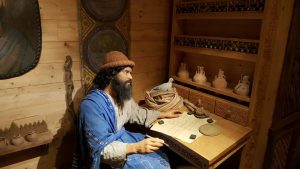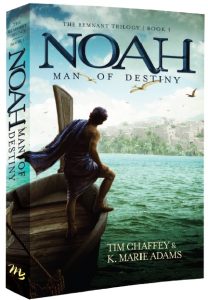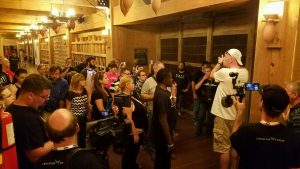I’m very excited to announce the publication of my latest novel, Noah: Man of Destiny, the first book in the Remnant Trilogy. Noah is an engaging coming-of-age adventure about one of the Bible’s most popular figures, but it is much more than just another novel. In fact, our main goal in writing the book was to help people learn how to discern between fact and fiction, between what is biblical and what is tradition that has been added to the Noah account over the centuries.
The book gives readers a new perspective on Noah while immersing them into the fascinating world that existed before the Flood—a time when people lived over 900 years and many, if not all, of the types of animals that are now extinct were still around.
In this blog post I’ll answer a handful of questions about the novel.
What is the plot?
I don’t want to give away too many details, so I’ll keep this answer short. The first book in the series is about Noah’s first few years after becoming an adult. He has an adventurous spirit and a desire to hone his woodworking skills rather than remain on the family farm. Leaving behind the fairly innocent surroundings of his childhood, Noah sets out to become a shipwright’s apprentice. This course of action brings him face-to-face with a world full of wonders and new dangers, including vicious beasts, slave traders, and a new belief system sweeping the earth that distorts and subverts biblical history. There’s also some romance, as he meets his future bride along the way, but his faithfulness to her and to his Creator face some intense challenges.
How can a novel help people discern between fact and fiction?
We included 40 pages of nonfiction at the end of the book to address questions that may arise. Some of these are apologetic in nature. That is, they provide answers to questions about the truth of Scripture.
Numerous questions and answers focus on ideas that many people have about Noah and the pre-Flood world that just aren’t found in Scripture. What we wanted to do was to break many of these stereotypes in order to help readers realize that these notions are not in the Bible. It isn’t that they are necessarily wrong, but we need to be able to discern between what the Bible actually states and what ideas people have added over the years.
I’ve read several books about Noah, and while there are some excellent reads, most of them cast Noah in the same light with a similar background. For example, I can count at least five books I’ve read where pre-Flood Noah is portrayed as a man who owns or works on a vineyard and he tends to like his wine a little too much. Obviously, this idea comes from the fact that Noah planted a vineyard after the Flood and became drunk. But the Bible doesn’t tell us his occupation prior to the Flood, and it specifically mentions that he began to be a man of the soil after the Flood (so he probably was not one prior to it). I think it makes far more sense to picture him as a skilled shipbuilder. God often calls those who have already been equipped for the task at hand.
Are you concerned that your artistic license may be seen as adding to Scripture?
There is always a possibility that some readers will latch on to certain notions, and if they aren’t careful, they may end up thinking the ideas come from Scripture. As I mentioned above, we want to help people learn how to avoid this practice. But let’s face it, we all use artistic license every time we read the Bible. When you think about David and Goliath, Moses and Pharaoh, or Noah and the Ark, what images come to mind? What hairstyles do you give them? What do their clothes look like? We automatically fill in details to flesh out the text. This isn’t necessarily a bad thing, but we need to be sure to discern between Scripture and our artistic license.
I believe there are two important points to make about using artistic license. First, I think you need to be up front about the fact that you are employing it. We included an introduction in the novel that mentions this and explains that the back of the book includes a nonfiction section. The second key is to make sure that you do not introduce any ideas that contradict the Bible.
How did the story come about?
One of my responsibilities for the Ark Encounter was to develop a backstory for Noah that would explain how he may have acquired the skills that allowed him to build the Ark. This storyline helped us keep our presentation of Noah consistent throughout the Ark, and it formed the basis of our Who Was Noah exhibit on the second deck.
After sharing the backstory with others, several of them suggested that I turn it into a novel. So I started brainstorming with my wife, and we soon developed a plot that would both entertain and educate readers. When the time came to start writing, I asked a good friend and coworker, K. Marie Adams, if she would be interested in coauthoring with me. I had read some of her unpublished writing and thought our styles would be complementary. She happily agreed so we spent the next month or so developing a tentative yet detailed outline of every chapter in the series. Then we started writing.
How did you depict the pre-Flood world?
Noah’s world is fairly lush, but unlike many pre-Flood novels, it does not have a uniform climate—we do not hold to the canopy model as some creationists do. We know that people at the time of the Flood were exceedingly wicked, but we have reason to believe that things were different during Noah’s early years. Genesis 4:26 tells us that after the birth of Seth’s son, Enosh, men began to call on the name of the Lord. Given the 900-plus year lifespans, Enosh’s generation could have still been around during Noah’s youth and may have exerted a godly influence that would diminish as their generation passed on. In our novel, Noah will encounter a city under the influence of a godly elder, and he will also come across a city eager to rebel against the old ways.
What can readers expect in books two and three?
In book two, Noah: Man of Resolve, readers will see the world plunge headlong into darkness. Expect more adventure, plenty of surprises, some tragedy, and an epic showdown between Noah and the leaders of the perverse religion spreading around the globe. We hope to have the second book out before summer 2017 and book three a year later. For book three, Noah: Man of God, readers will have to wait and see, but I don’t think it will be much of a spoiler to mention that it will include a certain large boat.
Is your novel the official Ark Encounter backstory for Noah?

Many of the things the animatronic Noah says at the Ark Encounter come from my latest novel, Noah: Man of Destiny, and its forthcoming sequels.
Not exactly. It is an expansion on the Ark Encounter’s official backstory as displayed in the exhibits at the Ark. But since I was responsible for the content of those exhibits, this book is as close as someone can get to an official Ark Encounter story.
One unique feature of the book is that we were able to intertwine the novel with several exhibits on the Ark. Certain items described in the book can be seen on the Ark, and some of the things said by the Ark’s animatronic Noah come directly from our story. We’ve included a section called “Encounter This” at the end of the book to let readers know which items can be seen and where they are located.
Where can I get a copy of Noah: Man of Destiny?
You can order a copy from my online store. It is also available from booksellers everywhere, including Answers in Genesis, Amazon (print or Kindle) and New Leaf Press. If you get a copy and enjoy it, would you kindly consider leaving a positive review on Amazon?



